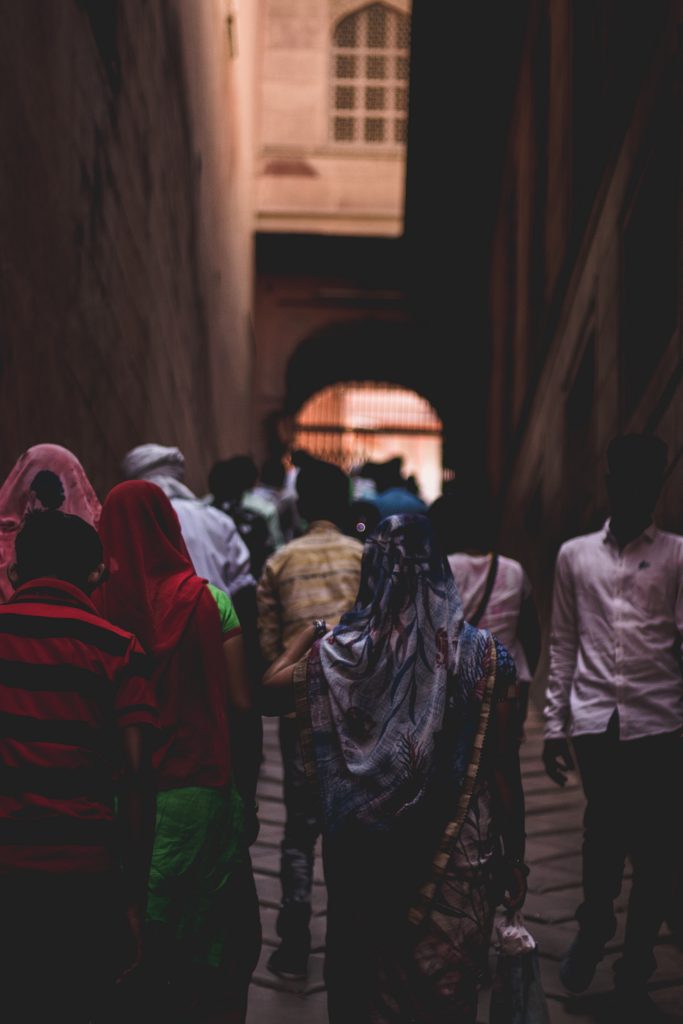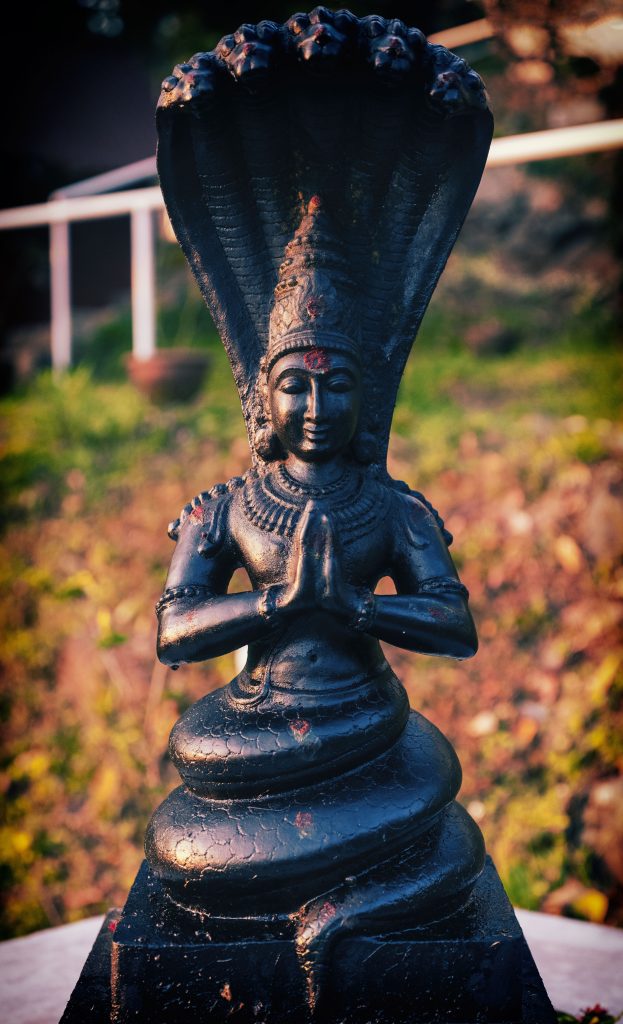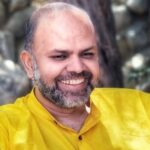We are all aware about Yogacharya T.Krishnamacharya being a pioneer in using yoga (specifically asana and pranayama) for therapy and well-being. But little did we know that he was a great scholar of our sacred knowledge and traditions. One of his long-standing students Raghu Ananthanarayanan has put together an interesting note about what is dhyAna and the interconnected nuances around it. He has used the device of an innocent conversation between a young, curious child, Chiku who is Gayatri Iyer, and an elderly teacher Rita, just like the dialogues that used to take place between student and teachers at ashrams. In my discussions with Raghu who is Rita in the writings, I learnt how symbols and rituals of our Hindu culture have been misinterpreted for long and once you know the real meaning, you can only marvel at the profundity of the entire meaning and how it is part of the larger divine order.
To read the first part of this conversation, click here.
Chiku: One of my friends also did Buddhist meditation and vipassana. Is it different from what you are talking about?
Rita: They are the same, except that in vipassana you start with observing the sensations in your body because then there is nothing left to imagination. Then the process of unfolding will start as one observes quietly.
Chiku: The process of getting in touch with your body, mind and emotions is a lot of churn. So, it is very difficult to stay still and just watch, I feel like running away before something happens. Why?
Rita: Chiku, this is the reality of the mind so that is a good observation.
Chiku: But what kind of a practice should I then do?
Rita: 1st chapter of yoga sUtra-s talk about abhAyasa and vairAgyam, and for us the practice keeps us oscillating from being deep and profound to becoming disturbed. To stay in that place of churn is the tapas.
Chiku: Do I also need shraddhA to stay in that place?
Rita: Just watch and observe. The beginning of distraction is when the mind tells you ‘Now, you have to or must stay there…’or say ‘you must find a way out’. Stepping away, you need to even watch how the mind is distracting you, that is also an understanding. Let me explain, most of the time you start the enquiry for a specific purpose or goal. For e.g. if I lose my temper, then I tell myself “I should not get angry and I must do something about it”. This is not true enquiry, you need to set aside this phala or objective because it will meddle with the process of dhyAna, then naturally you are not watching but only trying to control the outcome.

Chiku: I also become angry and sad when I try to quieten.
Rita: So, watch that also…where is it coming from?
Chiku: Yes, but I am angry or at conflict with myself that why have I not changed or why are all these things taking so much time? I have seen so many of my patterns come up regularly, but I am dedicatedly doing my sAdhana and ‘trying’ to watch but many times there is anger.
Rita: What does this anger do to you?
Chiku: Distracts me and causes some bodily reactions too.
Rita: Ok, so observe those things. But I am also hearing you make deal with this process saying, ‘I am doing this practice for so long yet why I am not getting results?’. You should see where this is coming from.
Chiku: Yes…true…like a child crying for a lollipop, and if I do not have it then I will just stand here and cry.
Rita: Just because you create certain conditions to sit and quieten that does not mean the inner voices have quietened.
Chiku: But what else can a person like a normal householder do?
Rita: Interestingly, the Upanishads say that the grihastha has the maximum opportunities because the path of the householder is very tough but very important in society.
Chiku: My mother is not very educated and is not well versed with yoga etc. But yet in the last 8-9 years I have seen so much change in her from being an agitated woman to be a quiet person, almost like in a state of vairagyam. She does many small routine works like putting kolams, cooking, puja and japa etc. Are these practices responsible for a change?
Rita: Well, I can only speculate, so it is not because of these rituals but something has triggered her to accept things around her as is. This inner quietness is what you are noticing when she does what you call the ‘small routines’ with attentiveness. The inner quietness would be reflected in all the activities that she undertakes.
Chiku: There are so many chores and responsibilities of family, career to manage, then where is the space to get into the deeper processes.
Rita: Ah! ChiKu, you just spoke about how your mother seems to have turned these very chores into her practice. That is why so many Upanishads, Mahabharata and Ramayana talk about like Rama, Krishna, as Shiva as householders. They are portrayed as people who have not only done extraordinary things but also as people who face everyday issues. Every experience you have and every engagement you have with life is a possible mirror.
Chiku: Did Krishnamacharya give any specific practices for a grihastha to do dhyAna?

Rita: You must do your nityakarma is what he said. He also recommended that you and pause every now and again, watch your breath regularly just like the Buddhists also say. Lastly, whatever you do must do be done with an attitude of seva.
Chiku: What is nityakarma?
Rita: nityakarma is daily practice. To illustrate, sandhyAvandana, or the morning prayer to the Sun comes down to give oneself a pause, reflecting on how one is engaging with one’s world and to doing pranayama. It is done three times a day just before eating. Obviously will enable us to introspect, eat mindfully and prepare ourselves for the next part of the day.
Time spent in quiet prayer, or a walk to the Temple are all meant to give scope for a pause, a stepping back from the pressures of the day.
Chiku: how is sevA going to help?
Rita: Do you like to paint?
Chiku: Yes
Rita: So, when you approach a painting you do it with care and love?
Chiku: Yes
Rita: So, if you approach every action with care and love, it will bring a quality of graciousness or lightness because you are paying so much attention to it. This is the starting of dhAraNA.
Krishna ji used to talk about 2 words when talking about meditation- The first word is contemplation which comes from the word ‘temple’ which is a space to observe and this is what the sUtra from the 3rd chapter is speaking about: deSha-bandhaH cittasya dhAraNA- deSham means space, bandhaH means to stay with and cittasya means observation of the mind.. The 2nd word is meditation, which comes from the root word ‘meditari’ which means to measure i.e. discovering an accurate measure of myself.
Now, dhyAna is a way to create space to observe myself and my vAsana and when I do that, I get a true measure of myself.
Chiku: I am trying to connect it to my day, where I do certain things throughout the day and in the evenings, I sit and watch a replay, which brings up some emotions like disgust, ecstasy or anger. So, I am not really sitting and doing dhyAna but more so a reflection. Will this help in the process of dhyAna?
Rita: This form of dhAraNA is recommended too because you are enquiring into your whole day and introspecting on the way you responded during the day. This is very real because you are getting in touch with your emotions at the body level too. This process if done before sleep is called it is very helpful.
This also answers your question how in a work-a-day life a grihastha who has many responsibilities, can do this process. If you are cooking and you can watch every action of yours attentively while you chop, stir etc. it is dhAraNA and it might take you to a stage of dhyAna. You may get sudden insights to your health, food habits etc.
Chiku: This is exactly like watching the mouse hole.
Rita: Correct
Chiku: One of my friend’s was telling me that in the Mandukya Upanishad, dhyAna is the process of exhausting one’s karmaphala. Which means I burn the vasana-s or residue of anything that has come through from my previous births. Is this true?
Rita: Chiku, I will avoid the discussion on the poorva janma because all I can deal with is what I am experiencing now. It is immaterial to discuss where the residue came from and why. What is material is to be able to take this process of watching oneself to more and more and more profound levels, so that the roots of the self get completely exposed or the seed energy gets completely exhausted. My teacher Krishnamacharya endorsed this too. Now as you go deeper, you may come across flashes of your birthing process, some old memories which a normal mind may not remember, which is fine. Breath work and vipassana also help you get in touch with these. The 2nd chapter of the yoga sUtra-s tells you very clearly to watch your avidyA, the unfolding and so on. This is a doable practice for a householder.
Chiku: Yet, all the meditation-mindfulness apps do not really help too much.
Rita: That is because they have simplified the idea for mass consumption. But sometimes, these practices invite people to go deeper than just relaxation. I think Krishnamacharya gave a very simple practice ‘just focus on your breath, see where is it going, pause and then follow it. It will automatically slow you, the pulse rate, the monkey mind etc. This is the starting point for pratyahara and dhAraNA
Chiku: Yes, I think all that you have said can only have meaning if they trigger me to look within and measure for myself where am I and what am I doing.
Rita: An external stick to beat yourself and make a progress chart is not going to help if you are a serious sAdhaka or seeker.
To understand more about how you can use dhyAna as a tool in your daily life, reach out to us at Ritambhara (ashram@ritambhara.org.in) where we, as a sangha, consciously walk the path of yoga.


 Anoop is a student of Yoga, an entrepreneur, a coach and a father of two young boys. He has led successful leadership stints in both the corporate and non-for-profit sectors. On encountering the country’s water/farmer crises at close quarters, he decided to pause and examine the impact various ‘isms’ – capitalism, colonialism, etc., were having on us as individuals, families, the society and the environment at large. This quest led him to formally engage with traditional Indic knowledge systems while also learning from the latest advances in science – about our physical and mental wellbeing, importance of body and mind work in healing trauma and the urgent need for a conscious rebuilding of family / work / social structures if we have to thrive individually and collectively. Insights, frameworks and processes gleaned from these on-going studies, an anchorage in his own personal practice and his wide-ranging experiences is what Anoop brings to facilitation/coaching spaces in Ritambhara and his various professional engagements.
Anoop is a student of Yoga, an entrepreneur, a coach and a father of two young boys. He has led successful leadership stints in both the corporate and non-for-profit sectors. On encountering the country’s water/farmer crises at close quarters, he decided to pause and examine the impact various ‘isms’ – capitalism, colonialism, etc., were having on us as individuals, families, the society and the environment at large. This quest led him to formally engage with traditional Indic knowledge systems while also learning from the latest advances in science – about our physical and mental wellbeing, importance of body and mind work in healing trauma and the urgent need for a conscious rebuilding of family / work / social structures if we have to thrive individually and collectively. Insights, frameworks and processes gleaned from these on-going studies, an anchorage in his own personal practice and his wide-ranging experiences is what Anoop brings to facilitation/coaching spaces in Ritambhara and his various professional engagements.
 Priya is a Yoga therapist in the Krishnamacharya tradition. She adapts Reiki & energy work, Vedic chanting, life coaching & Ayurvedic practices in her healing spaces. She is committed to nurturing collectives that have the praxis of Yoga at their heart.
Priya is a Yoga therapist in the Krishnamacharya tradition. She adapts Reiki & energy work, Vedic chanting, life coaching & Ayurvedic practices in her healing spaces. She is committed to nurturing collectives that have the praxis of Yoga at their heart. Anisha has been on an exploration to understand herself through yoga for the last 15years which led her to teaching yoga, yoga therapy and inner work through yoga.
Anisha has been on an exploration to understand herself through yoga for the last 15years which led her to teaching yoga, yoga therapy and inner work through yoga. Apoorva chanced upon Yoga in her early 20s. A spark was lit within and there was no turning back. Her exploration led her to the Krishnamacharya tradition more than a decade ago. Curious about human behaviour and what drives it, she was thrilled when her search ended (and also began) when she first came upon the Yoga Sutra, which illuminated a path towards answering many questions that had been held for a long time.
Apoorva chanced upon Yoga in her early 20s. A spark was lit within and there was no turning back. Her exploration led her to the Krishnamacharya tradition more than a decade ago. Curious about human behaviour and what drives it, she was thrilled when her search ended (and also began) when she first came upon the Yoga Sutra, which illuminated a path towards answering many questions that had been held for a long time. Anita is a yoga teacher and therapist in the tradition of Sri.T.Krishnamacarya and Sri T.K.V. Desikachar, a Reiki practitioner and a Life Coach. She is also the founder of Vishoka, a center for learning Indic and energy-based frameworks for living and healing. Her deep concern for human suffering and the problems of unsustainable living kept her on the path of seeking an integrated approach to looking at life, living, learning and healing.
Anita is a yoga teacher and therapist in the tradition of Sri.T.Krishnamacarya and Sri T.K.V. Desikachar, a Reiki practitioner and a Life Coach. She is also the founder of Vishoka, a center for learning Indic and energy-based frameworks for living and healing. Her deep concern for human suffering and the problems of unsustainable living kept her on the path of seeking an integrated approach to looking at life, living, learning and healing. Ankit is a seeker in the wisdom traditions of India. The core of his work includes creating dialogic spaces where people can look within and see the connection between their inner and outer lives. Inspired by the likes of Gandhi, Aurobindo, Vivekananda and Guru Gobind his experiments in service took him back to his roots in Punjab where he is creating a community-led model of higher education which is open, inclusive and accessible for all. Ritambhara for him is a space for engaging in a community which is committed to a DHramic life. He anchors his work of learning and leadership in the Antaranga Yoga Sadhana and the humanistic wisdom of Mahabharata.
Ankit is a seeker in the wisdom traditions of India. The core of his work includes creating dialogic spaces where people can look within and see the connection between their inner and outer lives. Inspired by the likes of Gandhi, Aurobindo, Vivekananda and Guru Gobind his experiments in service took him back to his roots in Punjab where he is creating a community-led model of higher education which is open, inclusive and accessible for all. Ritambhara for him is a space for engaging in a community which is committed to a DHramic life. He anchors his work of learning and leadership in the Antaranga Yoga Sadhana and the humanistic wisdom of Mahabharata.